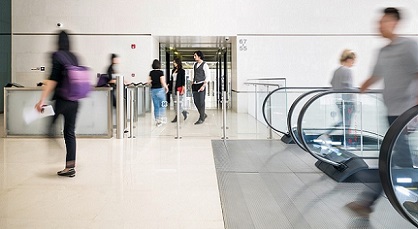 NATIONAL REPORT—With an eye on reducing carbon emissions, people moving has certainly evolved in recent years. One good example is the Tesla vehicles used in the Loop below the Las Vegas Convention Center. While a rare example of using electric vehicles to keep carbon impact down, much more common are the advances in energy efficiency in elevators and escalators in hotels and resorts around the world. Because of their presence in most lodging establishments, elevators especially have the potential to have a huge positive impact.
NATIONAL REPORT—With an eye on reducing carbon emissions, people moving has certainly evolved in recent years. One good example is the Tesla vehicles used in the Loop below the Las Vegas Convention Center. While a rare example of using electric vehicles to keep carbon impact down, much more common are the advances in energy efficiency in elevators and escalators in hotels and resorts around the world. Because of their presence in most lodging establishments, elevators especially have the potential to have a huge positive impact.
Green Lodging News recently spoke with Mark Freeman, SVP Modernization/M&A Integration at Schindler Elevator Corp. to learn more about what Schindler is doing to reduce its environmental impact. Schindler should know a thing or two about people moving technology. According to Freeman, its elevators and escalators move 1.5 billion people a day.
Schindler has been reducing the environmental impact of its machines for a long time. The company was founded in 1874. In 1996, Schindler’s permanent magnet gearless drive eliminated the need for a machine room, resulting in reduced space requirements, lower energy consumption, less noise, lower utilization of materials and the reduction of oil use. In 1999, Life Cycle Assessments were introduced to identify ways to improve the environmental performance of its products in all phases of an elevator’s life cycle. In 2002, energy recovery technology was introduced. With this technology, unused energy is fed back into the building’s electricity network, reducing waste heat and elevator cooling requirements.
Focus is on Elevator Operation
With the operational phase of an elevator having the most environmental impact, as compared to procurement or disposal, that is the focus of the company’s energy reduction efforts. For example, car lighting is automatically switched off when the elevator is not in use. PORT ECO mode places unused elevators on standby mode. “It senses the number of people using the elevator and stops moving some of them,” Freeman says. “It helps us dial back energy consumption.”
Other technological advances help group people with common destinations in the same elevators. “When you approach an elevator, we ask you what floor you are going to,” Freeman says. “The elevator will have two or three stops instead of 10 stops. We can move people around 30 to 50 percent more efficiently.”
Moving elevator passengers around more efficiently is part of Schindler’s Port Technology. PORT contains an eco-mode function that monitors the traffic conditions continuously and keeps average waiting times below or at the specified level, while saving as much energy as possible. PORT offers fully integrated building access, and myPORT—elevator control and security building access from a smartphone. “You can enter your desired floor from your mobile phone and get confirmation of which elevator you have been assigned to,” Freeman says.
The myPORT Technology offers different ways to travel through buildings without ever touching an elevator or even a door—ideal, of course, during a time of pandemic awareness.
Advancements in Escalator Technology
With its escalators, sensors give Schindler the ability to slow the escalator down and save up to 20 percent in energy. “Sensors show whether people are on the escalator, and sensors can see people approaching,” Freeman says. To help keep handrails clean, a system using UV rays can be mounted inside the escalator.
In addition to advancing technology to increase the efficiency of elevator and escalator movement, Schindler is also focused on material choices. “We are always looking at how we can use more sustainable materials and lighten the elevators,” Freeman says. “We are always asking, ‘What material can be recycled or made for recycling?’”
Schindler also spends a lot of time on route planning so mechanics can reduce miles driven. It is moving toward electric vehicles—it is currently replacing 500 sedans in its fleet with Toyota Prius Two vehicles—for its mechanics and its technology called Schindler Ahead enables Schindler to monitor an elevator remotely so that it can trouble-shoot from a distance and possibly even prevent a mechanic trip. Schindler’s goal is to reduce the CO2 intensity of its global vehicle fleet by 25 percent compared to 2017 by 2022.
At its elevator production facility in Hanover, Pa., 50 percent of the annual power needed by the plant is supplied by solar. Schindler has a zero waste to landfill goal of 2023. Eighty percent of all Schindler elevator materials and 90 percent of all Schindler escalator materials are suited for recycling. Seventy percent of their major production material suppliers are being ISO 14011 certified. Schindler wants to use 100 percent green electricity by 2025.
When asked what a hotel owner/developer should keep in mind when deciding on an elevator or escalator supplier, Freeman says to look for a company with a lot of experience and whose focus is on efficiency, cleanliness, safety, and reliability. “Make sure the company understands the importance of keeping a hotel running,” Freeman says.
Be sure to visit Schindler’s website for much more information on its green initiatives.
Glenn Hasek can be reached at greenlodgingnews@gmail.com.





